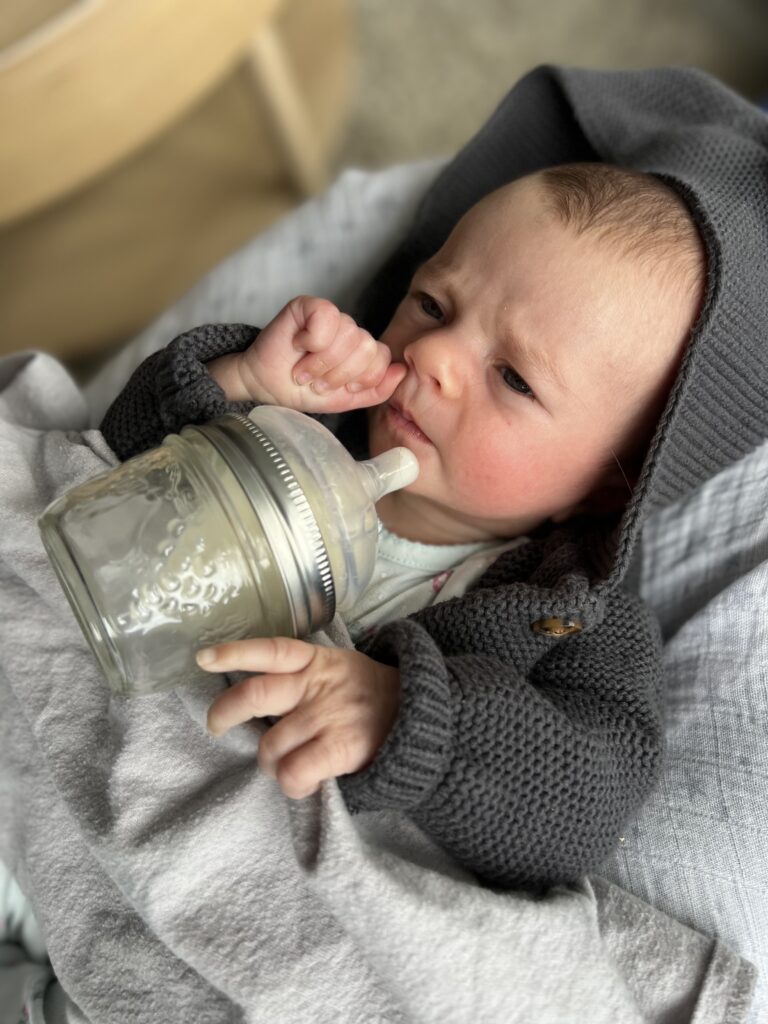The day I became a mother, I also became a cyborg.
The baby came out of my body, and my wireless pumps went onto my breasts. Well. Not permanently. But it certainly felt close enough. Making the decision to exclusively pump meant making a commitment to having robots go to town on my nipples six-to-eight times daily, extracting milk to bottle feed the baby. And I’d do it all again.
Exclusive pumping: it’s the secret third option for feeding your baby, and I didn’t know about it until I knew about it, y’know? At this point, I’m basically an evangelist for this somewhat alternative form of feeding.But googling furiously around the seventh-month mark of pregnancy (“what if I don’t want to breastfeed but also don’t want to use formula help”) revealed an unknown centrist possibility — a rigorous extraction schedule that offers both the nutritional benefits of breast milk and the convenience of formula, with a bonus sense of smug satisfaction that you will never need to complain about cluster-feeding.
Sure, it doesn’t feel good to admit you’re smug about a decision, but I honestly have no better word. I cracked the code. I had my cake and ate it, too — although this metaphor does not really cover the chapped-nipple element of the whole experience.
I’m no pioneer here. Approximately 85 per cent of breast- or chestfeeding parents use a pump at least sometimes — a number that is far higher in the U.S. since the Affordable Care Act came into play. But less than six per cent of parents feeding their babies breast milk do so exclusively through pumping, and fewer than 29 per cent of women had even heard of exclusive pumping as an option before giving birth.
Illinois-based mom Amanda Glenn, on the other hand, was an exclusive pumping early adopter, and eventually the founder of a whole website dedicated to the practice — ExclusivePumping.com. Back in 2011, when she had her first child, it was an act of necessity: her baby wasn’t gaining weight from direct feeding, so she turned to message board iVillage (“I’m really dating myself,” she laughs) for guidance as she ramped up the pumping. With her second baby, she found herself with some time on her hands as she sat in her office’s pumping room, and started to write down everything she learned. ExclusivePumping.com was born; the word about the benefits started to spread. “I had a lot of anxiety that my baby wasn’t getting enough milk, and pumping meant I could see how much he was eating,” she says. “You can’t always plan when the baby wants to eat, but you can plan when to pump. And I think exclusive pumpers tend to often be type A, organized, and like that.”
Some parents choose exclusive pumping because their work schedule is too demanding, or because of latching struggles, or medical reasons, or dealing-with-the-fallout-of-abuse reasons. All are obviously valid. But I chose exclusive pumping as a feminist rally: my time matters, my whims are valid, my boobs answer to me and me only. And I’m grateful the technology existed at this particular time in history to accommodate this proudly selfish choice.
At first, exclusive pumping was a grind, but it seems to me like there is no perfect way to do this — feeding, mothering, whatever. But for me, it was the least imperfect option. A way to give my baby whatever the alleged benefits of breastmilk are today, without giving up my autonomy. The milk would floweth, but on my schedule. And taking control of that one thing in a time of so much uncertainty and upheaval and joy and fear was a relief — even if it meant getting up at 2 a.m. to stuff my leaky breasts into my Elvie pumps: a sleek, Silicon-Valley-ified tech tool that had the look of a bulky, off-brand iPod.
The Elvie was (allegedly) discrete, it was efficient, it was designed for a girl on the go. Ultimately, it was the video demos that really sold me. The women in the ad were pumping during yoga classes, opening their small businesses (a cupcake bakery, obviously), and running the big meeting (presumably a parent company that owned several cupcake bakery franchises). Not that I had any big meetings to run, but I definitely wasn’t going to let some sort of cumbersome pump hold me back from the possibility.
I spent an afternoon learning how to assemble them, feeling overwhelmed, not knowing that in a few months time I would be assembling them with the precision and speed — blindfold me, sir — of a hotshot Marine in an army-movie training montage. Snap in the flange, pop on the shield, twist on the cup, then under the shirt, into the bra, crank up the suction, sir, yes, sir!
These second-hand, smuggled-in-from-America wireless pumps (sourced from Ebay because they aren’t approved for use in Canada, don’t at me) became an extension of my body: two robots, endlessly slurping away under my shirt. Gross. But isn’t all breast-feeding, if we’re being honest? Yes, yes, beautiful, natural, nourishment, the circle of life, the magic of Mother Earth, to each their own, et cetera, et cetera, but also objectively disgusting. Leaking, crusting, sucking, clogging, squirting, spilling, engorging, ew. We spend our whole lives trying to forget we are just animals who figured out how to use a zipper and a computer, and then a baby comes along and reminds you that you are mostly made of glands. Perhaps a more self-assured person than me finds something grounding about that.

Though I suppose, technically, the robots were doing the baby’s job (nursing), it was me whom they set free with their division of labour. My stockpile of milk was at the ready for anyone who wanted to whip up a bottle; my overflowing fridge like it belonged to one of those organization influencers on TikTok, showing off their bounty of Diet Cokes. It was revolutionary. There is no perfect way to feed a baby. There are compromises and downsides, whatever way you go — the first example of the lose-lose experience that parenting can sometimes be. But if you are a feminist resenting your male partner for his lack of mammary glands and also someone who is too cheap to buy formula for a whole year, exclusive pumping might be as good as it gets.
Anyone could feed that baby. My partner, my mom, visiting friends, children, grandparents, anyone who could hold a bottle could tap in; propped up at the right angle, our genius (well fed) baby could even feed herself. Every other night, it was my turn to sleep through, and I did, hard, blissfully unconscious, sweating through my sheets (this story is secretly a PSA about postpartum night sweats), as my partner dealt with the midnight snack. I was out all the time, the robo-tits clicking and clacking under my shirt, doing the dirty work while I snacked on fries or rode the bus or got a sunburn or spun on the dance floor. Sure, there were spills and leaks. But I felt as free as could be. I couldn’t fall into the martyr trap because I was driving a car and pumping. I was in the green room of comedy venues and pumping. I was hanging up blinds and pumping, wielding a power drill, electricity veritably surging through me in one of those moments where you disassociate and say, “Am I actually having it all?”
To be clear, my wireless pumps were absolutely not as discrete as the ads promised. It became a fun running joke that I got way hotter when I slipped in my robo-boobs and suddenly had a D-cup. “Can I buy you a drink?” my friends would say, mock flirtatiously. In addition to the, um, chestal girth, there were lights that flickered and shone through your shirt, a mechanical tick-tocking that occasionally caused confusion and alarm and building evacuations, but oh well. Other pumpers used tools that hung full-on, dairy-farm-inspired milk bottles from their chests — a look that even I, a Proud Pumper, would have struggled to rock out in the open — or found themselves plugged into the wall and missing out during a family wedding, tethered to the electrical grid instead of sloshing around during the Electric Slide as god intended.
Jordana Rumph, part of the ‘Mom Care’ customer care team for wireless-pump brand Willow, is obviously biased towards the magic of a hands-free, wire-free pumping set-up, but can you blame her? “It’s become more acceptable, more common, to exclusively pump, and I think that’s driven in part by innovation,” Rumph says. Rumph used a traditional electric hospital pump for her own exclusive pumping experience and describes it as “awful.” The development of in-bra, wearable pumps (Willow, the Elvie, the MomCozy, and their imitators) has been a game changer. “Your body can do this incredible thing to sustain your child, and now we can do it with some freedom.”
Preach, sister.
Of course, like literally everything in the world, your mileage may vary. As Bri McCoy, a certified lactation consultant with SimplyFed, puts it, “Pumps are like a pair of jeans; not every style is going to work for every person.” But the true beauty of this new, baby-feeding paradigm — not nursing, not formula-mixing, but somewhere in between — is that it’s one more opportunity for us to think, even for a moment, that we’ve found the answer. That we do have it all, that it wasn’t just a pipe dream; we can retain our real lives while effortlessly transitioning into the parents we want to be. We can give life our all, we can give our baby our all, and it’s just $249 plus shipping on eBay — and just a few spills to mop up along the way.




